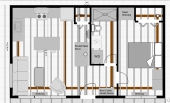
 4
4






 5
5




For all your Montana Masonry Heater parts (also known as) Rocket Mass heater parts.
Visit me at
dragontechrmh.com Once you go brick you will never go back!
 3
3




thomas rubino wrote:Hey Miguel;
Having a Walker cook stove makes a difference.
I suggest you build an 8" batch.
Foremost is your chimney 8" or 200mm are widespread and readily available sizes, ten inches is not.
An 8" batch is plenty of stove to share space with a Walker.
Plan on two burns to heat up the whole bell system.
 3
3








Glenn Herbert wrote:A bigger system would mean bigger fires, but not more frequently. As you are in a seriously cold climate with fairly steady heating needs, making the walls of a bell thicker would make the heating more stable and hold heat longer, at the cost of longer lag time before heat makes its way through the walls to your space. If you can fire up the Walker stove for some quicker heat if you really need it, I think I would go with the big fat batch box and expect to usually do fewer fires per day.
Your 317 m3 volume probably translates to around 120 m2 or 1200 square feet, which is not a large house. R-20-25 is fairly modest insulation for a real cold climate, even assuming the roof will be double that. In your situation, I would go with R-60 roof and R-30-40 walls and have less need for heating. Then I expect an 8" batch box plus a Walker stove would take care of you in any weather.
 1
1




Miguel Moreno wrote:Does having a bigger stove, like a 10" mean I have to burn bigger, more frequent fires to get it to work appropriately, even if I don't want want that much heat in the space?
regards, Peter




Peter van den Berg wrote:
Miguel Moreno wrote:Does having a bigger stove, like a 10" mean I have to burn bigger, more frequent fires to get it to work appropriately, even if I don't want want that much heat in the space?
The thing with a batchrocket is this: it can be run with half a load and burn very clean all the same. Even the duration of the burn is about the same as compared to a full load. I am used to long shoulder seasons so I run my heater once in two days or just once just to get the chill out of the house in such a situation.
Short answer: you could do half loads, once per day. A big fat heater could roughly been run once in two days. See it as a sliding scale, nothing to be worried about. Never run the heater for the heater itself, you are the one to be warmed so you are the commanding factor.
For the rest of the house: I'd second Glenn.

|
Bring out your dead! Or a tiny ad:
Rocket Mass Heater Resources Wiki
https://permies.com/w/rmh-resources
|





